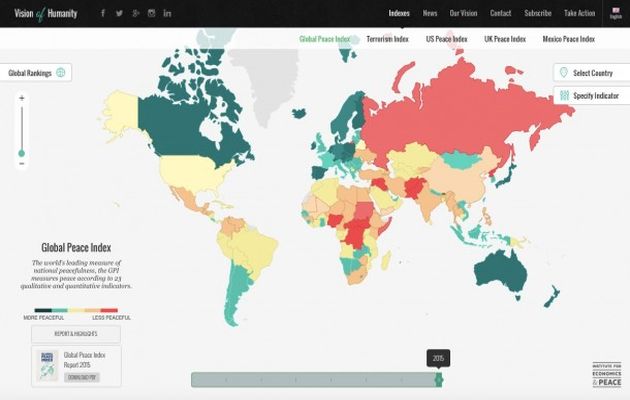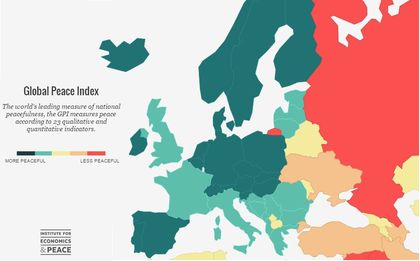Institute for Economics and Peace says global deterioration “was driven by increased terrorism and higher levels of political instability.” Europe is the most peaceful region in the world, but Ukraine is the second country whith a bigger deterioration.
 Global Peace Index /IEP
Global Peace Index /IEP
The Institute for Economics and Peace (IEP) has published its tenth edition of the Global Peace Index GPI: the world’s leading measure of global peacefulness. It gauges on-going domestic and international conflict, safety and security in society, and the degree of militarisation in 163 countries and territories by taking into account 23 indicators.
The most dangerous country is Syria , followed by South Sudan, Iraq and Afghanistan. The safest countries are Austria, Iceland, Denmark and Portugal. The 2016 edition expands its coverage by including Palestine for the first time.
A LESS PEACEFUL YEAR
The 2016 GPI shows the world became less peaceful in the last year, reinforcing the underlying trend of declining peace over the last decade. Results also show a growing global inequality in peace, with the most peaceful countries continuing to improve while the least peaceful are falling into greater violence and conflict
The global deterioration in peace in 2015 “was driven by increased terrorism and higher levels of political instability.” Deaths from terrorism increased by 80 per cent from last year’s report. The intensity of terrorism also increased with the number of countries suffering more than 500 deaths from terrorist acts more than doubling, up from 5 to 11.
The largest improvement since last year occurred in Central America and the Caribbean, while South America also made progress in its levels of peacefulness. Middle East and Africa (MENA) had the largest decline, followed by Sub-Saharan Africa, Europe and Asia Pacific respectively.
MIDDLE EAST AND AFRICA, AT THE TOP OF THE RANKING
This global deterioration is due to the developments in the MENA, already the least peaceful region in the world. So intense is the current concentration of violence and conflict in MENA that, when considered separately, the rest of the world’s average peace levels improved. Three of the five biggest country declines in peace occurred in the region: Yemen, Libya and Bahrain.
The other two countries which suffer a bigger deterioration in de Index, are Ukraine (156th place), due to the persistent conflict with pro-Russian separatist forces in the Donbass region, and Turkey (145th), because of the increasing impact of terrorism, as well as the escalation of violence and instability.
 Europe is the most peaceful region in the world/ IEP
Europe is the most peaceful region in the world/ IEP
TERRORISM GROWS WORDLWIDE
While the majority of terrorist activity is highly concentrated in five countries - Syria, Iraq, Nigeria, Afghanistan and Pakistan – the breadth of terrorism is spreading, with only 23% of countries in the Index not experiencing a terrorist incident.
Even Europe, which scored once again as the most peaceful region in the world, saw its average score deteriorate in this year’s report in the wake of terrorism incidents in Paris and Brussels, with deaths from terrorism in Europe having more than doubled over the last five years.
THE REFUGEE CRISIS
The number of refugees and displaced persons has risen dramatically over the last decade, doubling to approximately 60 million people between 2007 and 2016, nearly 1% of the world’s population.
There are now nine countries with more than 10% of their population displaced in some form; 20% of Somalia and South Sudan’s population respectively, and over 60% of Syria’s.
THE ECONOMIC COST OF VIOLENCE
The world continues to spend enormous amounts on creating and containing violence and little on building peace.
Although the global economic impact of violence dropped by 2% when compared to last year’s report, it was still a staggering $13.6 trillion in 2015, equivalent to 11 times the size of global foreign direct investment.
This represents 13.3% of world GDP, or $1,876 per person. In the last ten years the economic impact of violence was $137 trillion; greater than global GDP in 2015.
“POSITIVE PEACE”
The report concludes with new research into resilience and what the IEP identifies as ‘Positive Peace’: “the attitudes, institutions and structures which sustain peace.” In order to understand the complexity of this peace, the report presents systems thinking as it has developed in biology and ecology and applies it to the study of peace.
Countries with high Positive Peace are more likely to maintain their stability and adapt and recover from both internal and external shocks. Low Positive Peace environments are more likely to generate internal shocks, with 84 per cent of major political shocks occurring in these countries.

Las opiniones vertidas por nuestros colaboradores se realizan a nivel personal, pudiendo coincidir o no con la postura de la dirección de Protestante Digital.
Si quieres comentar o